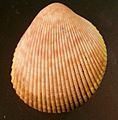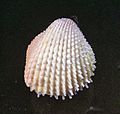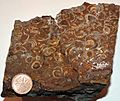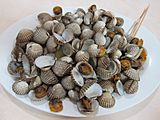Cockle (bivalve) facts for kids
Quick facts for kids Cockle (bivalve) |
|
|---|---|
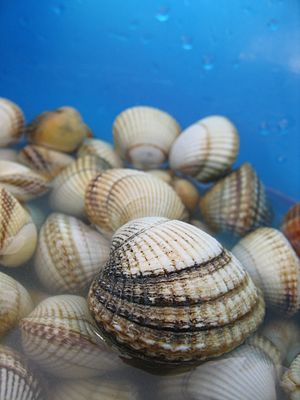 |
|
| Live specimens of Cerastoderma edule from France | |
| Scientific classification |
|
| Kingdom: | Animalia |
| Phylum: | Mollusca |
| Class: | Bivalvia |
| Subclass: | Heterodonta |
| Order: | Cardiida |
| Superfamily: | Cardioidea |
| Family: | Cardiidae Lamarck, 1809 |
| Subfamilies | |
|
|
| Synonyms | |
|
Lymnocardiidae |
|
A cockle is a type of edible bivalve mollusc that lives in the sea. Think of it as a small, tasty clam! While many small, edible bivalves are sometimes called cockles, the "true" cockles belong to a special family called Cardiidae.
True cockles usually live in sandy, calm areas along beaches all over the world. Their shells are easy to spot because they are round and have a unique shape. If you look at them from the end, they look like a heart! Most cockle shells also have many evenly spaced ridges, or "ribs," that go from the center outwards. However, some, like the egg cockles (genus Laevicardium), have very smooth shells.
A cool thing about a cockle's shell is that it can close completely. This means there are no gaps around the edges when it's shut tight. Even though cockle shells might look a bit like scallop shells because of the ribs, you can tell them apart. Scallops have little ear-shaped parts near their hinge, which cockles don't have. Also, cockles live buried in the sand, while scallops can swim around or attach themselves to things.
Cockles have a special body part called a mantle. This mantle has three openings. These openings help the cockle take in water, push water out, and stick out its foot. Cockles use their strong foot to dig into the sand. They eat tiny plants and animals called plankton by filtering them from the water. Did you know cockles can even "jump"? They do this by bending and straightening their foot quickly! Like many bivalves, cockles can change their sex depending on what's best for them, and some species grow up very fast.
Sometimes, seafood sellers might call other small, edible bivalves "cockles" even if they aren't true cockles. These might be from different families, like the Venus clams (Veneridae) or ark clams (Arcidae). That's why true cockles from the Cardiidae family are sometimes called "true cockles" to avoid confusion.
Contents
Types of Cockles
There are more than 205 types of cockles alive today, and many more have been found as fossils.
The most common type is the common cockle, Cerastoderma edule. You can find this one all around the coastlines of Northern Europe. Its range stretches from Ireland in the west, up to the Barents Sea in the north, over to Norway in the east, and as far south as Senegal.
Another type is the dog cockle, Glycymeris glycymeris. It lives in similar places to the common cockle, but it's not a true cockle. It belongs to a different family called Glycymerididae. Dog cockles are safe to eat, but they can be a bit tough when cooked.
The blood cockle, Tegillarca granosa, is also not a true cockle. It's part of the ark clam family (Arcidae). These are grown in large numbers from southern Korea all the way to Malaysia.
Cockle Families
Here are some of the groups (called genera) within the Cardiidae family:
- Acanthocardia
- Acrosterigma
- Americardia
- Cerastoderma
- Clinocardium
- Corculum
- Ctenocardia
- Dinocardium
- Discors
- Fragum
- Fulvia
- Glans
- Hypanis
- Laevicardium
- Lophocardiium
- Lunulicardia
- Lyrocardium
- Microcardium
- Nemocardium
- Papyridea
- Parvicardium
- Plagiocardium
- Pratulum
- Ringicardium
- Serripes
- Trachycardium
- Tridacna, also known as "giant clams"
- Trigoniocardia
- Vasticardium
-
Fossil Cardiidae shells (Late Cretaceous, Alberta, Canada).
Cockles in Food and Culture
Cockles are a popular type of edible shellfish in many parts of the world, both in Eastern and Western cooking. People collect them by raking them from the sand when the tide is low. Collecting cockles can be hard work and even dangerous if you don't pay close attention to the local tides. For example, in 2004, a sad event happened in Morecambe Bay where many people were caught by the rising tide. This shows how important it is to be careful when collecting shellfish.
In England and Wales, people are allowed to collect a small amount (5 kg) of cockles for themselves. But if you want to collect more than that to sell, you need a special permit.
Cockles are also a popular street food in countries like Cambodia.
Cockles Around the World
In the United Kingdom, cockles are often sold as a cooked snack. They are boiled and then seasoned with malt vinegar and white pepper. You can find them at seafood stalls, often alongside mussels, whelks, jellied eels, crabs, and shrimp. You can also buy them pickled in jars or in sealed packets with vinegar. A traditional Welsh breakfast sometimes includes cockles fried with bacon and served with a special seaweed dish called laverbread.
In Southeast Asia, boiled cockles are sold at many food centers. They are used in popular dishes like laksa, char kway teow, and steamboat. In the Malay language, they are called kerang, and in Cantonese, they are called see hum.
In Japan, a type of cockle called the Japanese egg cockle (Laevicardium laevigatum) is used to make a kind of sushi called torigai sushi.
It's important that cockles are prepared correctly before eating. If they are not handled properly, they can sometimes cause health problems.
Cockles in Culture
Cockles are also used as bait for many types of sea fish. You might have heard of cockles in songs or rhymes! The famous folk song "Molly Malone" is also known as "Cockles and Mussels" because the main character sells these foods. The shells of cockles are also mentioned in the English nursery rhyme "Mary, Mary, Quite Contrary". Native peoples in North America also traditionally ate cockles.
-
Bags of cockles picked from Morecambe Bay
-
These boiled "cockles" in Tanjong Pagar, Singapore, are actually ark clams in the family Arcidae
What Does "Warm the Cockles of My Heart" Mean?
You might have heard the English phrase "it warms the cockles of my heart". This means that something has made you feel very happy and content deep inside.
There are a few ideas about where this phrase comes from. One idea is that it comes directly from the heart-like shape of a cockle shell. Another idea is that it's linked to the scientific name for the main group of cockles, Cardium, which comes from the Latin word for heart. Some people think it comes from a Latin word meaning "little heart," or even from a Latin word for the ventricles (chambers) of the heart, cochleae cordis.
See also
 In Spanish: Berberechos para niños
In Spanish: Berberechos para niños


